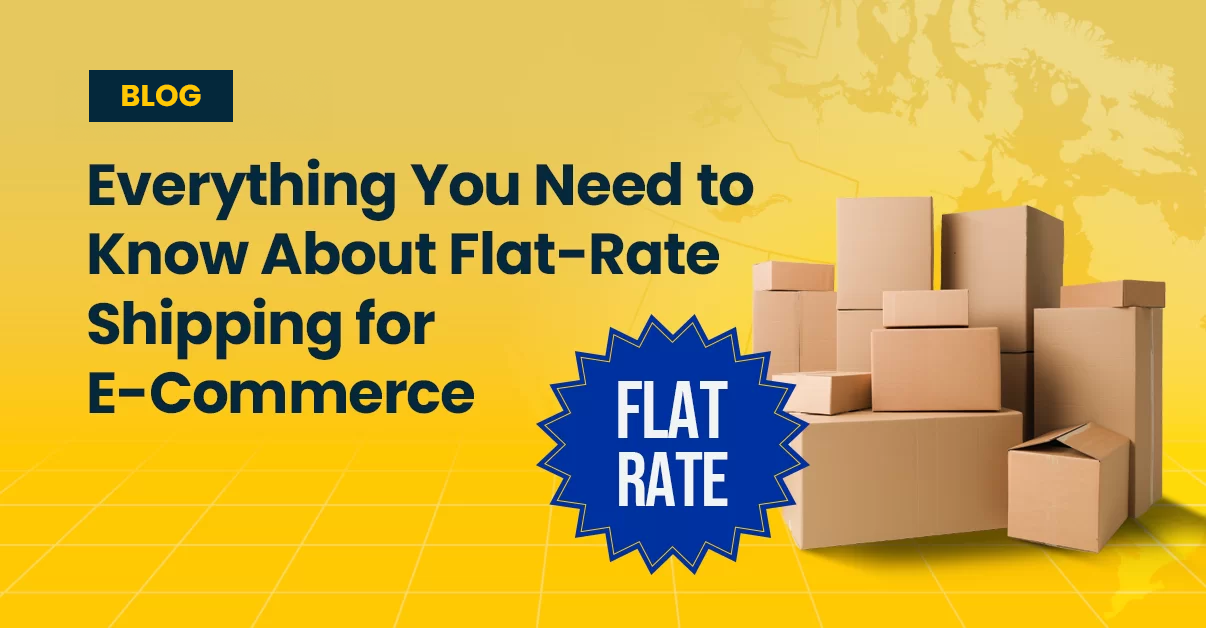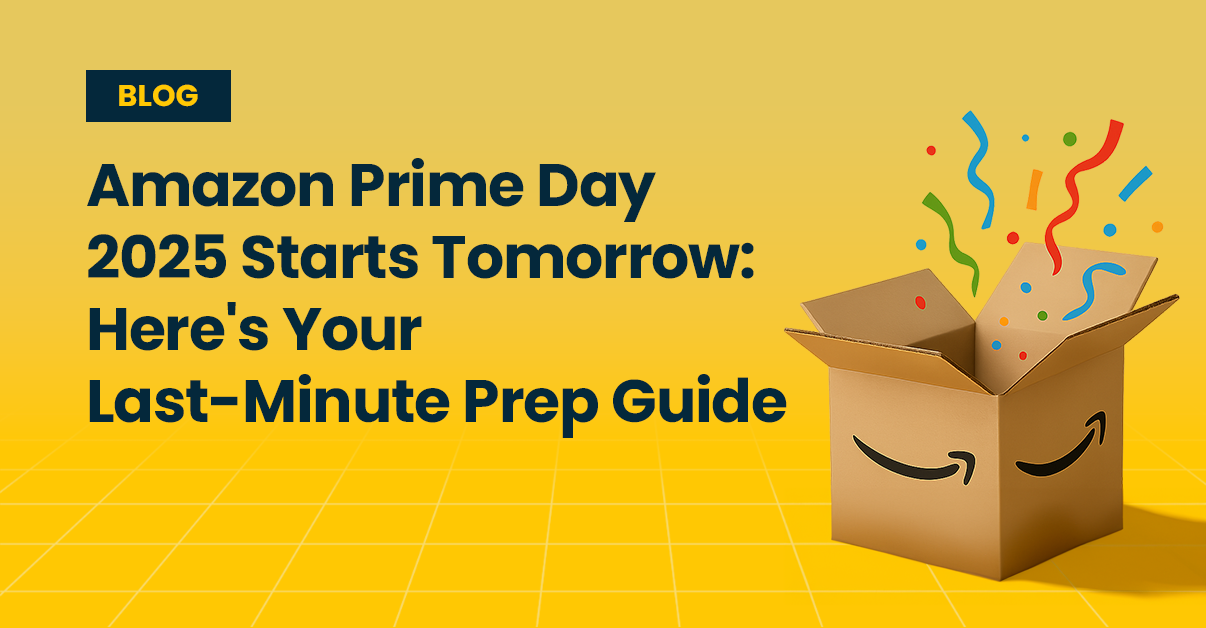Shipping cost shouldn’t be the reason you lose a sale, but for many e-commerce businesses, it is. Between rising costs, vast delivery zones, and growing customer expectations, getting products from your warehouse to someone’s doorstep is more complex (and costly) than ever. And when nearly 48% of shoppers abandon their carts over unexpected shipping fees, and 66% expect free shipping, there’s not much room for error.
That’s where flat-rate shipping can make a big difference. It’s a straightforward, reliable pricing model that brings clarity to your checkout, control to your costs, and confidence to your customers.
Let’s break down what flat-rate shipping is and help you find out whether it’s the right fit for your business or not.
What Is flat-rate shipping?
Flat-rate shipping is a pricing method where the shipping cost stays the same—no matter the weight, size, or distance (as long as it’s within a defined limit or zone). Whether you’re shipping a small item across the city or a heavier package across provinces, the fee doesn’t change.
Instead of calculating cost based on dimensional weight, distance, or delivery speed, flat-rate shipping offers a fixed price for packages that meet specific criteria—usually based on box size or maximum weight. For example, an online store might charge a flat $10 for any order within Canada. Whether the package contains one small item or a box of heavier goods (within the set limits), the shipping fee doesn’t change.
This model eliminates price fluctuations tied to fuel, weight, or seasonal demand. It’s a straightforward way for e-commerce brands to manage logistics, improve cost transparency, and create a smoother checkout experience for customers.
In short: one price, no surprises. That’s the power of flat-rate shipping.
How flat-rate shipping works
While the concept of flat-rate shipping is straightforward, how you implement it as an e-commerce business depends heavily on your carrier’s options and your own pricing strategy.
As we already know, flat-rate shipping means charging a fixed fee to ship a package, regardless of its weight, dimensions, or distance—within defined limits set by the carrier. Some brands go with one flat fee per order. Others charge per item. Some offer free shipping over a certain cart value, and a flat rate below it. And then there’s the behind-the-scenes stuff—like the difference between what you charge customers and what you actually pay to ship an order. The goal? To make shipping predictable for customers and easier to manage for you.
So how does it actually work?
Most flat-rate shipping options are offered by carriers through predefined flat-rate programs. In almost all cases, you will need to use carrier-approved packaging or adhere to maximum weight and size thresholds to qualify for the flat rate. Once you meet those conditions, the cost stays the same—whether you’re shipping across town or across the province.
What you can control
As a merchant, you don’t set the carrier’s flat-rate terms—but you do control how those rates appear in your store. You can:
- Charge a flat fee per order, per item, or based on cart value
- Match the carrier’s rate exactly, add a margin, or subsidize the cost as part of a promotion
- Combine flat-rate shipping with free shipping thresholds to boost conversions
Here are the most common approaches e-commerce businesses take when offering flat-rate shipping:
| Approach | How it works | Example | Best for |
| Flat rate per order | One fixed fee per order, regardless of quantity or weight (within limits). | $8 shipping for any order across Canada, whether it’s 1 item or 10. | Simple pricing, everyday orders |
| Flat rate per item | A fixed shipping cost charged per item in the cart. | $5 per item → 3 items = $15 shipping. | Bulky items or separate shipments |
| Conditional flat rates | Shipping fee changes based on cart value. Encourages higher spending. | – $10 for orders under $50- $5 for $50–$75- Free over $75 | Incentivizing larger orders |
| Customer fee vs. actual cost | What you charge may differ from your real cost; you average it out over time. | Charge $10 flat. If cost = $8, you gain $2. If cost = $12, you lose $2. | Balancing shipping margins |
| Carrier-based flat rates | Your shipping cost is also fixed via prepaid services like Canada Post or Ecom Express. | Use carrier-specific flat-rate service for predictable cost. | Fixed-cost delivery with national coverage |
| Speed and service options | Most flat rates apply to standard delivery, but you can offer options for faster service. | – Standard: $5 flat (5–7 days)- Express: $15 flat (1–2 days) | Letting customers choose speed at fixed prices |
As you can see, there’s no single “right” way to do flat-rate shipping. The best setup depends on your product size, margins, and how much flexibility you want to give your customers.
Benefits of flat-rate shipping for e-commerce businesses
If you’re running an online store, you know shipping isn’t just about getting a package from point A to point B—it’s about customer experience, conversion rates, and your bottom line. Flat-rate shipping simplifies it all. Here’s how it can work in your favour as a business.
1. More predictable costs
Flat-rate shipping brings consistency. Managing shipping to multiple zones across Canada can quickly become a logistical burden. Different provinces, rural versus urban addresses, and regional surcharges create a fragmented cost structure. Flat-rate shipping flattens that curve. It enables you to maintain consistent pricing across geographies, reducing the need for zone-based rate tables or region-specific rules.
2. Reduced weight disputes
Weighing every product, especially in bulk operations, takes time and increases the risk of error, particularly when you must calculate volumetric weight for larger boxes. With flat-rate shipping, you only need to confirm the order fits within the defined packaging or slab threshold. Your team can skip the scale and focus on packing, resulting in a faster, more consistent workflow and fewer slowdowns on the warehouse floor.
3. Built for hybrid models
Flat-rate shipping fits well into flexible strategies. You might charge a flat $9.99 for standard shipping and offer free shipping above a set threshold, or let customers upgrade to express at carrier-calculated rates. With a consistent baseline cost, you can run promotions and pricing experiments without worrying about fluctuating delivery costs.
4. Easier to scale without losing control
As your e-commerce business grows, managing shipping across more products, more customers, and more regions gets complicated. Flat-rate shipping brings structure to the chaos. It allows you to expand without needing to overhaul your shipping rules for every new product or destination. Whether you’re selling nationwide or expanding to new provinces, a flat-rate model simplifies pricing and keeps the experience consistent for your customers.
Flat-rate shipping isn’t just about convenience—it’s a strategy. It helps e-commerce businesses improve margins and simplify delivery. And when your delivery partner offers flat-rate options, it becomes even easier to implement at scale, giving you one more edge in a competitive market.
What to consider before offering flat-rate shipping
Flat-rate shipping has its perks—but like any strategy, it works best when it’s tailored to your business. Before you roll it out, here are a few things worth thinking through:
1. What are you actually shipping?
If your products are all roughly the same size and weight, flat-rate shipping is a no-brainer. But if you’re selling everything from tiny accessories to bulky home goods, a one-size-fits-all rate might not cut it.
You don’t want to lose money every time someone buys a heavy item—or accidentally overcharge for something that weighs next to nothing. In cases like that, it might be smarter to create different flat rates for different product categories.
2. Where are your customers?
Shipping across Canada isn’t always straightforward. Sending something to Toronto? Easy. Shipping to a remote part of Northern B.C.? That’s going to cost more.
If most of your orders stay within major cities, a flat rate can work really well. But if you ship nationwide, it helps to partner with a carrier that offers consistent, Canada-wide flat-rate options—so you’re not caught off guard by those high-distance delivery costs.
3. What’s your average shipping cost?
Flat-rate shipping is all about finding balance. If you charge too little, you’ll chip away at your profit. If you charge too much, customers might walk away before checking out.
Take a look at your recent shipping data. What are you typically paying to ship an order? Use that as your starting point, then add a small buffer to cover the outliers—like peak season rates or larger packages.
4. Should you offer a free shipping threshold?
Flat rates and free shipping thresholds work really well together—but only if the numbers make sense for your margins.
Maybe you offer flat $7 shipping under $75, and free shipping above it. That gives shoppers a reason to spend more. Just make sure the threshold isn’t so high that people give up trying to reach it. The goal is to increase cart size without hurting your bottom line.
5. Are you making it clear enough?
The last thing you want is a customer asking, “Wait, how much is shipping again?” If your policy is unclear or shows up too late in the process, it could cost you the sale.
So make it obvious. Put it in your banner, your FAQ, your product pages, wherever it makes sense. If you’re offering flat $5 shipping or free over $50, tell them upfront. Clarity builds trust, and that trust leads to conversions.
Flat-rate shipping can be a huge win, but only if it’s done thoughtfully. When you’ve got a good understanding of your costs, your customers, your products, and a delivery partner who can help you keep things predictable, it becomes way easier to make flat-rate work for your business.
Choosing the right carrier: Why it matters
Flat-rate shipping only works if your carrier supports it. Some providers require you to use their boxes; others allow custom packaging within specific dimensions. Most also have weight limits to avoid penalties.
This is why choosing the right delivery partner is critical. The best carriers don’t just offer flat-rate shipping, they make it easy to integrate into your operations, reduce your costs, and create a seamless experience for your customers.
Why is Ecom Express a smart choice for you?
At Ecom Express, we get it—shipping isn’t just a box-checking task. It’s one of the first real impressions your customers get of your brand. That’s why we’ve built our last-mile delivery service with growing e-commerce businesses in mind. Simple, fast, and reliable—just the way it should be.
Same-day and next-day where it counts
Need to get orders out fast? We’ve got you covered. We offer same-day and next-day delivery across major Canadian cities. So whether it’s a regular Tuesday or Black Friday chaos, we help you deliver on your promise.
Flat rates, no guesswork
Our pricing is straightforward: flat rates with no hidden fees. No fuel surcharges, no peak-season surprises. Just one clear cost that helps you plan ahead—and makes life easier for your customers at checkout.
Shopify-friendly (and hassle-Free)
We plug right into platforms like Shopify, so you can generate labels, track orders, and send updates without jumping between tools. It’s a smoother process from start to finish, saving you time and keeping things organized.
Built to keep up
Whether you’re shipping ten orders or ten thousand, our tech helps you stay in control. From real-time tracking to proof of delivery, everything is designed to keep your team—and your customers—in the loop.
Shipping that’s greener, too
We’re not just fast—we’re forward-thinking. With a growing fleet of electric vehicles, we’re working to lower emissions and make last-mile delivery more sustainable. Because great service shouldn’t cost the planet.
Whether you’re just starting out or scaling up fast, we’re here to make your shipping experience simpler and smarter.
Make shipping work for you
Flat-rate shipping isn’t just a pricing tactic, it’s a customer experience and business strategy rolled into one. For Canadian e-commerce brands, it offers a simple way to reduce friction, and keep shipping operations under control.
But like any strategy, it works best when it’s tailored to your product mix, audience, and cost structure. Whether you use flat-rate exclusively or as part of a hybrid model, having a reliable delivery partner can make all the difference.
Ecom Express is here to help you bring speed, predictability, and clarity to every delivery. Because at the end of the day, it’s not just about shipping, it’s about trust, loyalty, and growing your business. Let’s make every delivery count.
Contact us to know more.
Frequently asked questions
1. Is flat-rate shipping cheaper than standard shipping?
Not always—but it can be. Flat-rate shipping helps control costs by charging a consistent fee, which works well if most of your orders are similar in size or weight. For heavier or long-distance shipments, flat rates may be more economical. However, if your packages are usually lightweight or local, calculated standard shipping could cost less. It really depends on your product mix and shipping zones.
2: Can I offer both flat-rate and standard shipping on my store?
Yes! Many e-commerce businesses use a hybrid model—flat-rate shipping for domestic or average-size orders and standard shipping for larger, international, or more complex shipments. Most e-commerce platforms like Shopify or WooCommerce allow you to set up multiple shipping rules or zones. This flexibility gives your customers options while allowing you to better manage shipping costs.
3. What happens if my actual shipping cost is higher than my flat rate?
You’ll absorb the difference. Flat-rate shipping is based on averages—some orders may cost more to ship, while others cost less. Over time, these differences usually balance out. To avoid losing money consistently, review your shipping data regularly and adjust your flat rate if needed. Partnering with a carrier that offers national flat-rate options (like Ecom Express) can also reduce the risk of big cost swings.
4. How do I choose the right flat-rate amount to charge?
Start by reviewing your average shipping cost per order over the past few months. Factor in packaging, fuel surcharges, and carrier fees. Add a small buffer to account for remote deliveries or heavier items. Keep your rate competitive—but sustainable. You can also test flat-rate pricing alongside a free shipping threshold to find what drives conversions without hurting your margins.
5. Is flat-rate shipping suitable for international orders?
Usually not. Flat-rate shipping works best for domestic deliveries where you have more control over distance and cost variables. International orders involve customs, duties, variable carrier fees, and greater distance-based pricing, making it hard to apply one flat rate without overcharging or undercharging. For international shipping, standard calculated shipping is typically more accurate and scalable.




